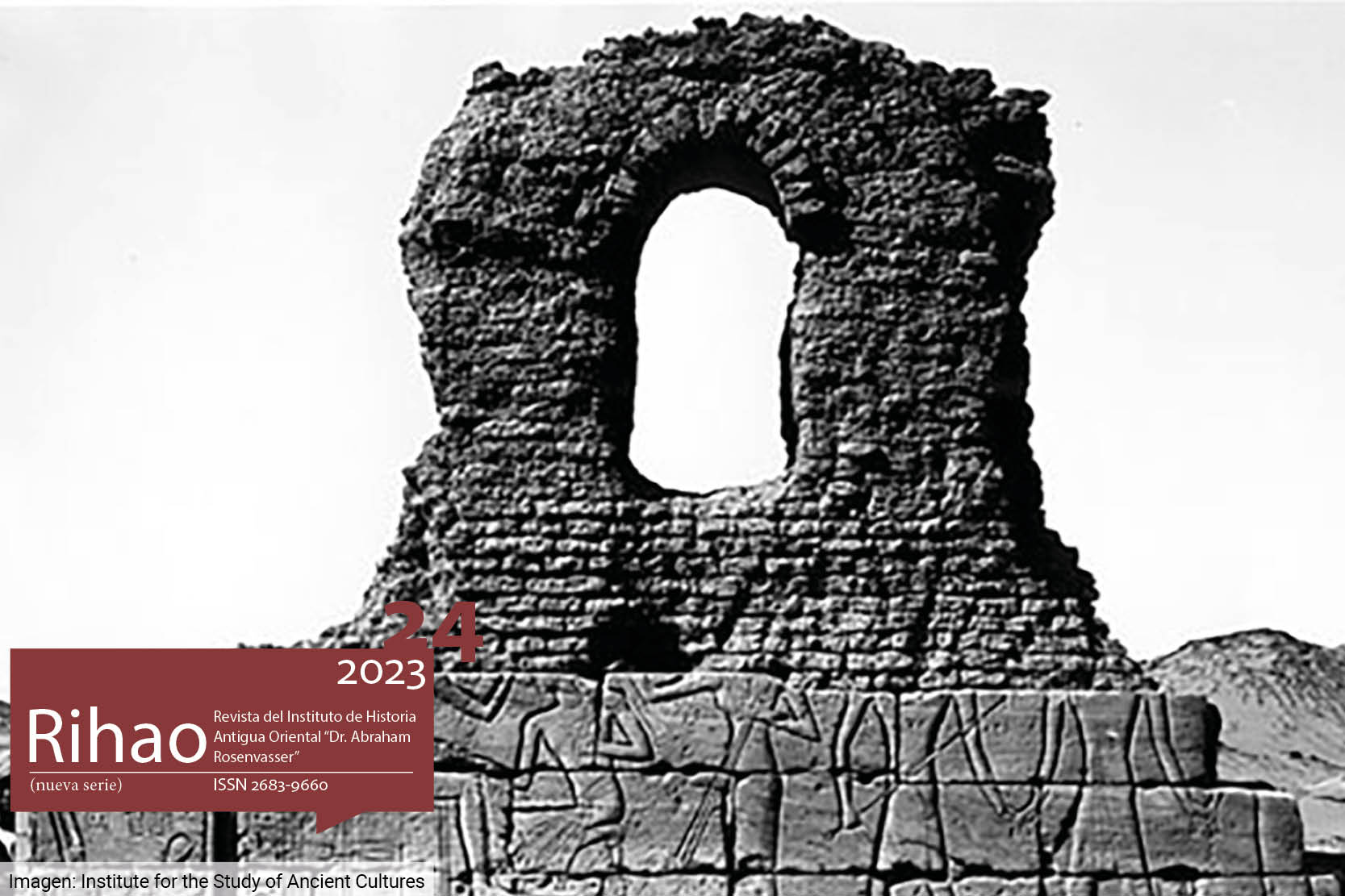25 años de trabajos arqueológicos y epigráficos en Saqqara. Reconstruyendo la tumba de Imephor Impy Nikauptah de Kom el-Khamasin
Resumen
Entre 2019 y 2022 han tenido lugar las excavaciones arqueológicas de la Universitat Autònoma de Barcelona en la necrópolis de Kom el-Khamasin, en Saqqara suroeste. El yacimiento ha sido excavado en su totalidad. El “Proyecto Kom el-Khamasin”, sin embargo, es mucho más antiguo. Empezó con una pequeña prospección en el año 1997, por lo que en 2022 se cumplieron los 25 años. La prospección no dio paso a una excavación porque en 1999 el lugar fue objeto de un violento saqueo que destruyó los edificios funerarios que hubo en él y supuso que muchas piezas (bloques y fragmentos de bloques de caliza decorados y estatuillas funerarias) fueran robadas y aparecieran después en el mercado de antigüedades de todo el mundo. En este trabajo se explica la historia de este proyecto de investigación y, a partir de toda la evidencia recuperada del lugar (tras el saqueo de 1999 y durante las excavaciones recientes) y rastreada en el mercado de antigüedades, se procede a la reconstrucción de la tumba del personaje mejor documentado de la necrópolis: el sumo sacerdote de los dioses Ptah y Sokar de Menfis llamado Imephor Impy Nikauptah.Descargas
Citas
Borchardt, L. (1913). Das Grabdenkmal des Königs Śaȝḥu-ReꜤ II. Die Wandbilder (Wissenschaftliche Veröffentlichungen der Deutschen Orient-Gesellschaft 26), 2 vols. Leipzig: J. C. Hinrichs.
Brugsch, H. (1891). Thesaurus Inscriptionum Aegyptiacarum. Altägyptische Inschriften, V: Historisch-Biographische Inschriften. Leipzig: J. C. Hinrichs.
Cervelló Autuori, J. (2007). L’épigraphie de Kom el-Khamasin (Saqqâra Sud, fin Ancien Empire-début PPI). Rapport préliminaire, en: Bulletin de l’Institut Français d’Archéologie Orientale 107: 71-87.
Cervelló Autuori, J. (2016). Kom El-Khamasin. Histoire accidentée d’un site archéologique égyptien, en: Collombert, P., Lefèvre, D., Polis, S. y Winand, J. (eds.), Aere perennius. Mélanges égyptologiques en l’honneur de Pascal Vernus (Orientalia Lovaniensia Analecta 242). Lovaina: Peeters, 17-41.
Cervelló Autuori, J. (2018). The high priesthood of Memphis during the Old Kingdom and the First Intermediate Period: An updated study and prosopography, en: Trabajos de Egiptología. Papers on Ancient Egypt 9: 7-63.
Cervelló Autuori, J. (en prensa). The Kom el-Khamaseen Project, 1997-2022, en: Jiménez Serrano, A. (ed.), Old Kingdom Art and Archaeology 8th Conference (Arqueologías. Serie Egiptología). Jaén: Editorial de la Universidad de Jaén.
Cervelló Autuori, J. y Díaz de Cerio, M. (2006). A New Old Kingdom ỉmy-r ʿ(ȝw) from the Memphite Region. Results from a Survey at a Site in the South Saqqara Desert, en: Annales du Service des Antiquités de l’Egypte 80: 85-96.
Cervelló Autuori, J. y González León, D. (2023). A Memphite high priest at the fall of the Old Kingdom, en: Egyptian Archaeology 62: 8-12.
Cervelló Autuori, J. y González León, D. (próxima publicación). A Horus Behdety and a royal daughter from the private necropolis of Kom el-Khamaseen (South Saqqara).
Connor, S. (2019). Killing or ‘de-activating’ Egyptian statues: who mutilated them, when, and why?, en: Masson-Berghoff, A. (ed.), Statues in Context. Production, Meaning and (Re)uses (BM Publications on Egypt and Sudan 10). Lovaina / París / Bristol: Peeters, 281-302.
Cour-Marty, M. (1997). Les poids inscrits de l’Ancien Empire, en: Berger el-Naggar, C. y Mathieu, B. (eds.), Études sur l’Ancien Empire et la nécropole de Saqqâra dédiées à Jean-Philippe Lauer (Orientalia Monspeliensia 9). Montpellier: Centre d’Egyptologie, Université Paul-Valéry, 129-145.
Dawood, K. (2005). Animate decoration and burial chambers of private tombs during the Old Kingdom: New evidence from the tomb of Kairer at Saqqara, en: Pantalacci, L. y Berger-El-Naggar, C. (eds.), Des Néferkarê aux Montouhotep: Travaux archéologiques en cours sur la fin de la VIe dynastie et la Première Période Intermédiaire (Travaux de la Maison de l’Orient et de la Méditerranée 40). Lyon: Maison de l’Orient et de la Méditerranée, 107-127.
Decker, W. y Herb, M. (1994). Bildatlas zum Sport im alten Ägypten (Handbuch der Orientalistik I, 14), 2 vols. Leiden / Nueva York / Colonia: Brill.
Diego Espinel, A. (2006). Etnicidad y territorio en el Egipto del Reino Antiguo (Aula Aegyptiaca-Studia 6). Bellaterra: Servei de Publicacions de la UAB.
Dobrev, V., Laville, D. y Onézime, O. (2015). Nouvelle découverte à Tabbet el-Guech (Saqqarâ-sud). Deux tombes des prêtes égyptiens de la VIe dynastie, en: Bulletin de l’Institut Français d’Archéologie Orientale 115: 111-144.
Doxey, D. M. (1998). Egyptian Non-Royal Epithets in the Middle Kingdom: A Social and Historical Analysis (Probleme der Ägyptologie 12). Leiden / Boston / Colonia: Brill.
Fischer, H. G. (1975). An elusive shape within the fisted hands of Egyptian statues, en: Metropolitan Museum Journal 10: 9-21.
González León, D. (2021). A prosopographical study of the ỉmȝ-ʿ title holders down to the end of the Old Kingdom: Part 1 - Commentary, en: Zeitschrift für ägyptische Sprache 148: 154-176.
González León, D. (2022). A prosopographical study of the ỉmȝ-ʿ title holders down to the end of the Old Kingdom: Part 2 - Corpus, en: Zeitschrift für ägyptische Sprache 149: 44-55.
Hannig, R. (2003). Ägyptisches Wörterbuch I. Altes Reich und Erste Zwischenzeit (Hannig-Lexica 4). Maguncia: Philipp von Zabern.
Hannig, R. (2006). Ägyptisches Wörterbuch II. Mittleres Reich und Zweite Zwischenzeit (Hannig-Lexica 5), 2 vols. Maguncia: Philipp von Zabern.
Harpur, Y. (1987). Decoration in Egyptian Tombs of the Old Kingdom. Studies in Orientation and Scene Content. Londres / Nueva York: Routledge & Kegan Paul.
Hays, H. M. (2015). The entextualization of the Pyramid Texts and the religuos history of the Old Kingdom, en: Der Manuelian, P. y Schneider, T. (eds.), Towards a New History for the Egyptian Old Kingdom: Perspectives on the Pyramid Age (Harvard Egyptological Studies 1). Leiden / Boston: Brill, 200-226.
Jéquier, G. (1929). Tombeaux de particuliers contemporains de Pepi II (Fouilles à Saqqarah). El Cairo: Imprimerie de l’Institut Française d’Archéologie Orientale.
Jones, D. (2000). An Index of Ancient Egyptian Titles, Epithets and Phrases of the Old Kingdom (British Archaeological Reports-International Series 866), 2 vols. Oxford: Archaeopress.
Kanawati, N. (2010). Decorated Burial Chambers of the Old Kingdom. El Cairo: Supreme Council of Antiquities.
Labrousse, A. (en prensa). La nécropole du roi Pépy Ier à l’Ancien Empire tardif et à la Première Période Intermédiaire, en: Pillon, A. (ed.), Chronologies and Contexts of the First Intermediate Period (Bibliothèque d’Etude). El Cairo: IFAO.
Larcher, C. (2022). The se(te)m priest: an officiant of royal ceremonies, en: Sánchez Casado, R. y Morales, A. J. (eds.), Priestly Officiants in the Old Kingdom Mortuary Cult (Monografías de Oriente Antiguo 3). Madrid: Universidad de Alcalá, 113-159.
Legros, R. (2016). Stratégies mémorielles: les cultes funéraires privés en Egypte ancienne de la VIe à la XIIe dynastie (Travaux de la Maison de l’Orient et de la Méditerranée 70). Lyon: Maison de l’Orient et de la Méditerranée.
Marchand, S. (2004). Histoire parallèle. La céramique et les dépôts de fondation de l’Égypte ancienne, en: Egypte, Afrique & Orient 36: 7-20.
Maystre, C. (1992 [1948]). Les grands prêtres de Ptah de Memphis (Orbis Biblicus et Orientalis 113). Gotinga / Friburgo: Vandenhoeck & Ruprecht / Universitätsverlag.
Miniaci, G. (ed.) (2023). Breaking Images: Damage and Mutilation of Ancient Figurines (Multidisciplinary Approaches to Ancient Societies 2). Oxford / Filadelfia: Oxbow.
Monnier, F. (2021). La voûte en chevrons monumentale. Comportement mécanique, pathologie et évolution, en: Legros, R. (ed.), Dans les pas d’Imhotep. Mélanges offerts à Audran Labrousse (Orient & Méditerranée 36). Lovaina / París / Bristol: Peeters, 49-65.
Pérez Die, M. C. (2004). The ancient necropolis at Ehnasya el-Medina, en: Egyptian Archaeology 24: 21-24.
Picardo, N. (2007). ‘Semantic homicide’ and the so-called reserve heads: The theme of decapitation in Egyptian funerary religion and some implications for the Old Kingdom, en: Journal of the American Research Center in Egypt 43: 221-252.
Ranke, H. (1935). Die ägyptischen Personennamen, I: Verzeichnis der Namen. Glückstadt: J. J. Augustin.
Russo, B. (2010). La vipère à cornes sans tête. Étude paléographique et considérations historiques, en: Bulletin de l’Institut Français d’Archéologie Orientale 110: 251-274.
Scheele-Schweitzer, K. (2014). Die Personennamen des Alten Reiches. Altägyptische Onomastik unter lexikographischen und sozio-kulturellen Aspekten (Philippika. Marburger altertumskundliche Abhandlungen 28). Wiesbaden: Harrassowitz.
Tefnin, R. (1991). Les têtes magiques de Gizeh, en: Bulletin de la Société française d’égyptologie 120: 25-37.
Valloggia, M. (2021). Une monnaie de compte de l’époque de Rêdjedef provenant d’Abou Rawash, en: Legros, R. (ed.), Dans les pas d’Imhotep. Mélanges offerts à Audran Labrousse (Orient & Méditerranée 36). Lovaina / París / Bristol: Peeters, 111-116.
Vandier, J. (1958). Manuel d’archéologie égyptienne, III: Les grandes époques. La statuaire. París: Picard.
Vernus, P. (1982). Name, en: Helck, W. y Otto, E. (eds.), Lexikon der Ägyptologie IV. Wiesbaden: Harrassowitz, 320-326.
Vittmann, G. (2013). Personal names: function and significance, en: Frood, E. y Wendrich, W. (eds.), UCLA Encyclopedia of Egyptology. Los Ángeles: University of California.
Ward, W. A. (1982). Index of Egyptian Administrative and Religious Titles of the Middle Kingdom. Beirut: American University of Beirut.
Woods, A. (2015). Five significant features in Old-Kingdom spear-fishing and fowling scenes, en: Kousoulis, P. y Lazaridis, N. (eds.), Proceedings of the Tenth International Congress of Egyptologists (Orientalia Lovaniensia Analecta 241). Lovaina / París / Britosl: Peeters, 1897-1910.





.jpg)







